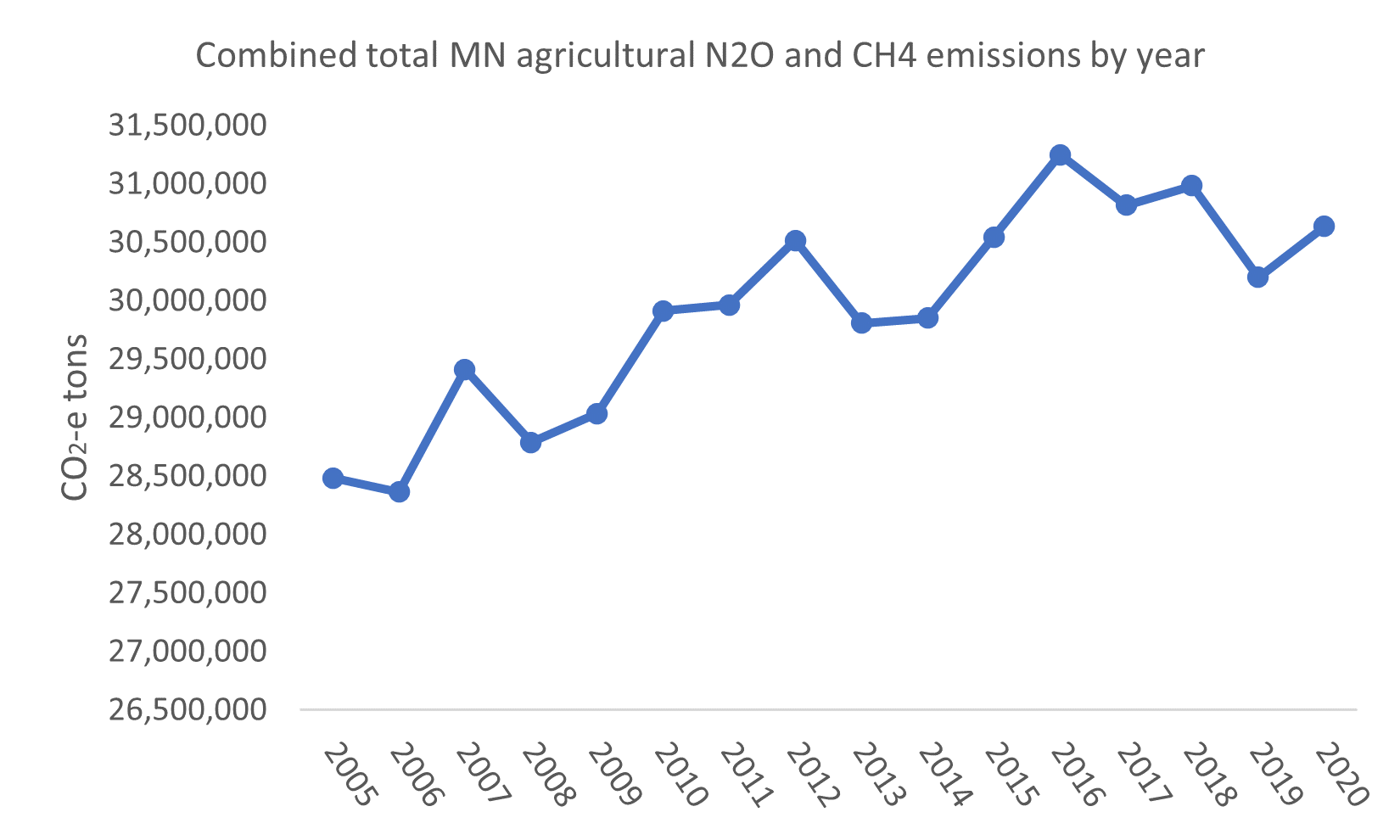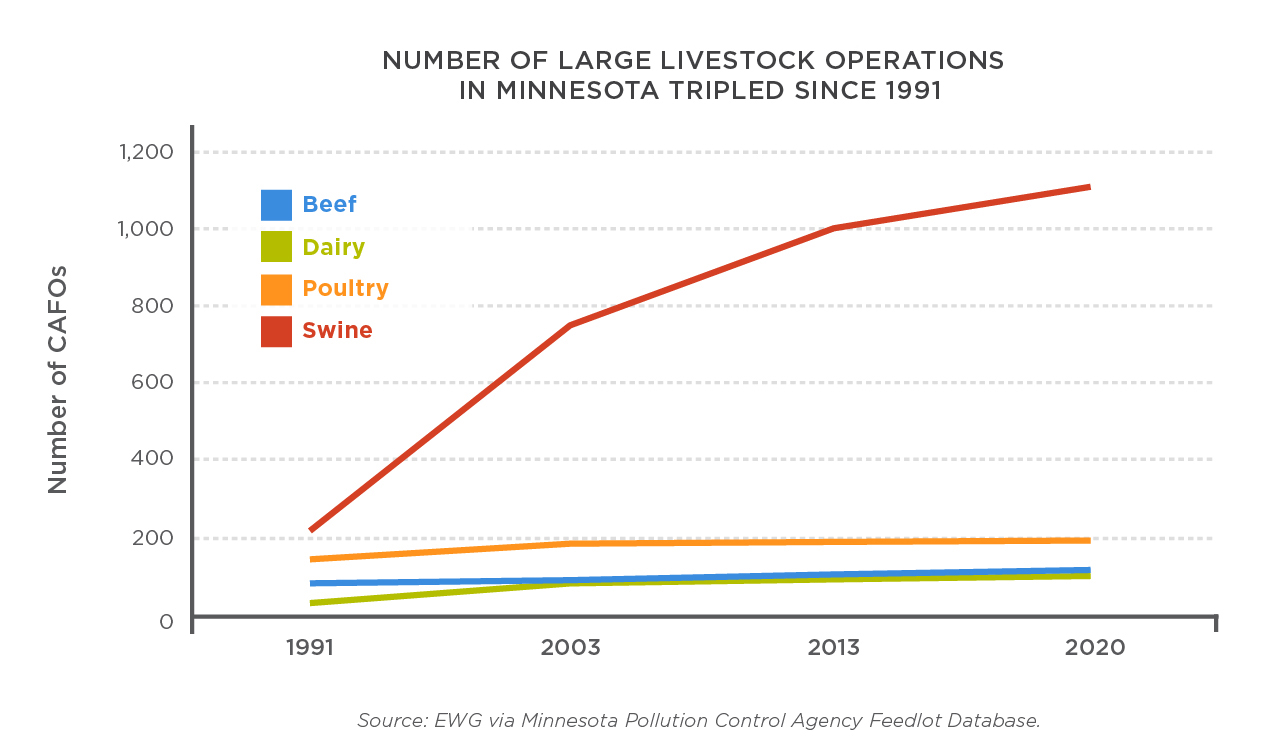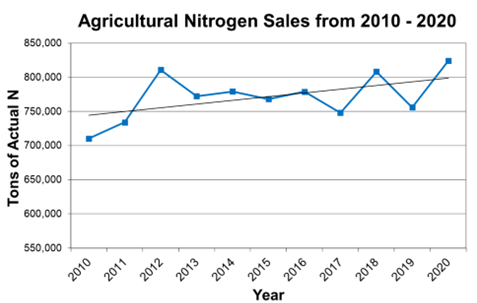View a PDF of this report.
Summary
The latest biennial greenhouse gas (GHG) emissions data from the Minnesota Pollution Control Agency (MPCA) shows major emission reductions since the last report, finding a 23% reduction in overall emissions from 2005-2020. While the state is now on track to meet its GHG emission reduction goals, the MPCA cautions that the pandemic-related shutdown was likely a significant factor in the recent sharp decline and that emissions may return to pre-pandemic levels. The new data show that the agriculture sector is the state’s largest source of emissions, with emissions slowly rising. A major share of the agriculture sector’s emissions is tied to large-scale concentrated animal feeding operations (CAFOs) for dairy, hogs and beef. Agriculture is the state’s largest source of the potent GHGs methane and nitrous oxide. Governor Tim Walz’s climate framework supports more climate-friendly, less-emitting farming systems, particularly those focused on regenerative agriculture practices that enhance soil health. However, it will be difficult to reduce agriculture emissions significantly without addressing the state’s continued reliance on and expansion of CAFOs.
Minnesota’s Agriculture Emissions
Minnesota’s Next Generation Energy Act (passed in 2007) used 2005 as a baseline to set targets to reduce emissions in the state by 15% by 2015, 30% by 2025 and ultimately 80% by 2050. Minnesota did not meet the 2015 target but due to a pandemic-aided drop in emissions (see below) is on track to meet the 2025 target. Since 2005, Minnesota’s emissions have declined 23%. It is possible emissions will rise again when future data includes the re-opening of businesses, schools and other institutions in the state that were closed during the height of the pandemic shutdown. Governor Walz’s Climate Action Framework (CAF) targets a 50% reduction in 2005 level emissions by 2030, to reach net zero by 2050.

While emissions in other sectors, such as electrical generation (down 54%) and transportation (down 18%), have declined since 2005, agriculture emissions have been slowly rising. Agriculture is responsible for nearly one-quarter of the state’s emissions and is the highest source of two potent GHGs, methane and nitrous oxide. Methane is a short-lived but extremely potent gas: It has around 80 times more warming potential than carbon dioxide over a 20-year timespan but only lives in the atmosphere for around a decade. Nitrous oxide is 273 times more potent than carbon dioxide over a 100-year period.

The state has elected to combine agriculture and forestry into one land-based sector, unlike at the federal level where the Environmental Protection Agency separates the two sectors. Forests, including re-growth and new plantings, can act as a carbon sink. While that sink does not sequester carbon from any emitting sector in particular, MPCA has tied it to agriculture.
Agriculture-related emissions within the state have risen steadily since 1990, including emissions from animal agriculture (primarily methane from cows, and methane and nitrous oxide from manure) and crop agriculture linked to growing nitrogen fertilizer use (tied to expanded corn acres).


According to the MPCA, since 2005, methane emissions from animal agriculture have increased 10% in the state, and nitrous oxide emissions related to both manure and synthetic fertilizer use have increased 9%. MPCA reports that “Animal agriculture is Minnesota's largest source of methane emissions, specifically from manure management and cattle digestion.” Rising nitrous oxide emissions, according to MPCA, are linked to “a variety of agricultural sources, including nutrient application, crop residues, and runoff. Animal agriculture also produces nitrous oxide from manure.”
Ruminant animals like cows naturally emit methane through their digestive process, mostly through burps. Minnesota’s shift toward more large-scale CAFOs for dairy, beef and hog production over the last several decades has required more capacity to store the massive amounts of concentrated manure under those systems. That type of concentrated manure storage emits both methane and nitrous oxide, particularly when that manure is liquified and sprayed on fields. The shift toward a CAFO systems explains why methane emissions from animals (ruminants) have remained relatively flat since 2005, while emissions from manure have risen. The CAFO system contrasts with well-managed grazing-based systems that emit fewer GHGs and in which manure is spread more appropriately on fields with long-rooted, perennial pasture.
The updated data shows a long-term increase in methane from manure and ruminants since 2005, with an increase from ruminants and a slight decline from manure from 2018-2020.
|
Sources
|
GHGs
|
2005
|
2010
|
2015
|
2017
|
2018
|
2020
|
|
Manure
|
CH₄
|
2,655,597
|
3,030,879
|
3,079,583
|
3,174,756
|
3,396,291
|
3,064,240
|
|
Ruminants
|
CH₄
|
5,373,991
|
5,563,424
|
5,518,560
|
5,550,030
|
5,533,421
|
5,742,391
|
Similarly, emissions are rising from nitrous oxide, linked to high nitrogen fertilizer use on crops (primarily corn), increases in feedlot-related nitrous oxide emissions, with slight declines in manure and runoff-related emissions.

The CAFO Connection
Since the 1980s, Minnesota and much of the United States have undergone a transition toward CAFOs to raise animals. CAFOs raise large numbers of animals in smaller spaces, often indoors, and rely on feed crops (such as corn and soybeans) rather than pasture to feed animals. CAFOs produce an enormous amount of waste, which is often stored in manure lagoons. The MPCA estimates that the amount of manure generated by livestock in Minnesota would be equivalent to that of a human population of about 50 million. While the state has lost tens of thousands of farmers over the last several decades, the number of animals (particularly hogs) has risen dramatically. We now have fewer, larger farms raising more animals. Linked to the growth in CAFOs is a rise in acres for corn and soybeans used to feed animals.

Source: Porter, Sarah and Craig Cox. “Manure Overload: Manure Plus Fertilizer Overwhelms Minnesota’s Land and Water,” Environmental Working Group, https://www.ewg.org/interactive-maps/2020-manure-overload/, (accessed March 2023).
In the latest U.S. Department of Agriculture Census, Minnesota lost 130 hog producers from 2012-2017, but the number of hogs in the state grew by 850,000. The state lost 16% of its dairy farms from 2016-2019, while dairy herd size grew 16% over the same period, according to the Minnesota Department of Agriculture (MDA). As more farmland has shifted toward animal feed, Minnesota has lost valuable pastureland, including long-rooted grasses that can sequester carbon. Since 2012, Minnesota experienced a 27% loss of pastureland.
Rising Fertilizer Use
The rise in CAFOs and corn ethanol production has propelled an increase in corn acres in Minnesota and associated nitrogen-based fertilizer sales in the state since 2010.

Nitrogen-based fertilizers are a major source of the potent GHG nitrous oxide.

CAFOs and GHG Reporting
Currently, feedlots with 50 or more animal units in Minnesota must be permitted with the Minnesota Pollution Control Agency. There are an estimated 18,000 registered feedlots in the state. New or expanding feedlots that exceed 1,000 animal units (714 dairy cows, 1,000 beef cows, 3,334 hogs) are required to complete an environmental assessment worksheet (EAW) on the impact of the proposed operation on the air, water and land, and how the project will mitigate those impacts. Last year, the state’s Environmental Quality Board approved new requirements for projects undergoing an EAW, including the reporting of potential greenhouse gas emissions and how the project will adapt to expected climate impacts, such as extreme weather events. The new requirements will provide additional information on how new or expanding CAFOs may impact the climate, but the requirements are anticipatory, without monitoring or a review on accuracy in the years to come. Additionally, the state has not set any limits on emissions per project or accumulative emissions per year, so the new CAFO reporting requirements are limited to informational purposes.
What’s Next?
Governor Walz’s climate action framework, announced in 2022, sets new emissions reduction targets aligned with the Intergovernmental Panel on Climate Change (IPCC) and the U.S. climate commitment as part of the Paris Agreement. These goals include reducing the state’s GHG emissions by 50% (from 2005 levels) by 2030, achieving net-zero emissions by 2050 and prioritizing investments in climate resilience over the next 10 years.
The framework includes a climate-smart natural and working lands plan with immediate and long-term strategies, guided by two goals:
-
Increase by 25% the amount of carbon sequestered and stored annually in natural and working lands, compared to 2014-2018 average levels.
-
Reduce annual GHG emissions in the working lands sector by 25% from 2018 levels.
The framework assigns multiple agencies to work on calculating carbon sequestration on natural lands and to set resilience and adaptation metrics. It prioritizes greater technical assistance for farmers to improve soil health and support for emerging farmers. It hopes to accelerate forest, wetland, grassland restoration and species diversity, as well as to promote local and community-based agriculture to reduce transportation needs and increase food access. The framework would also promote and expand the use of cover crops and perennial crops that can better hold water and limit nitrogen pollution.
Significant scientific uncertainty raises questions about the state’s reliance on carbon sequestration in the agriculture and land sector. Scientists have not yet answered important questions about how much carbon can be sequestered in dynamic natural systems and for how long by various practices. The latest IPCC report concluded that there is not a one-to-one relationship between precisely measured industrial sources of emissions and less scientifically certain (and less permanent) land-based carbon sequestration, including farmland sequestration. The scientists found that climate change itself, through rising temperatures and the increasing frequency of extreme weather events, will slow or disrupt the soil’s ability to sequester carbon on farms and forests over time. An emerging body of research is highlighting the complexities of measuring soil carbon in the short and long term. Parts of the U.S. have already seen extreme weather events literally burn through forest-based carbon sequestration projects.
It will be challenging to reach the Walz framework goal of a 25% reduction in emissions on working lands without addressing the continued expansion of the CAFO system in the state. The framework targets the challenge of reducing methane and nitrous oxide emissions but focuses primarily on better nutrient and manure management, rather than the need to place limits on the CAFO system.
Conclusion
In the early 1970s, President Nixon’s Agriculture Secretary Earl Butz told farmers to “get big or get out.” Since then, but particularly accelerating after the 1996 Farm Bill, the North American Free Trade Agreement and the U.S. entry into the World Trade Organization, U.S. agriculture has become more concentrated and more globalized. Many agriculture markets are controlled by global companies, such as Smithfield/WH Group, JBS, Tyson Foods and Cargill. Minnesota farmers operate within this global system of production and markets. Several U.S. Farm Bill programs, from commodity supports to crop insurance to government-backed loans, support the production of cheap animal feed for CAFO production to feed this global market. Renewable Fuel Standards and other policies have driven the expansion of the corn ethanol industry. This is the challenging playing field many of the state’s farmers are operating in.
Minnesota can leverage the influx of federal resources coming into the state from the Inflation Reduction Act to expand conservation spending (including to prioritize climate benefits) and the Infrastructure Bill to build out local infrastructure for meat and food processing to better support pasture-based systems and community food systems. IATP’s analysis of conservation spending in the state finds that in 2022 only 8% of farmers who apply for assistance through the conservation stewardship program (CSP) were awarded contracts. While the numbers are better (26.5%) for Minnesota farmers applying for the Environmental Quality Incentives Program (EQIP), three out of every four farmers who apply are turned down. These numbers show there is enormous interest from the state’s farmers to implement conservation practices and whole farm systems that could both reduce emissions and build climate resilience.
The EQB’s new reporting requirements for greenhouse gas emissions on new or expanding CAFOs is welcome and will aid in tracking some of the sector’s emissions. However, to achieve the reductions necessary to respond to the climate crisis and meet the Governor’s targets, the state must begin the challenging conversation about how to stem the continued expansion of CAFOs, identify limits to growth (not only to reduce GHGs, but also water pollution and biodiversity) and work with farmers in the state on a transition strategy toward less-emitting, more climate-resilient farming systems.
View a PDF of this report.